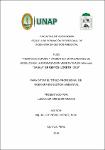Tiempo de reposo y ambientes enraizadores de hijuelos en la propagación vegetativa de Aloe vera "sábila" en Iquitos. Loreto - 2018
Abstract
La investigación de realizó con el objetivo de determinar si el tiempo de reposo y
ambientes de almacigado de hijuelos influye en el enraizamiento y crecimiento de la
planta de sábila en vivero, manejado en condiciones climáticas de la región Loreto.
El diseño estadístico es el Diseño Irrestrictamente al Azar (DIA), con 15
replicaciones. Los tratamientos en estudio fueron seis: T1=0 días de reposo, en
ambiente libre, T2=10 días de reposo, en ambiente libre, T3=20 días de reposo, en
ambiente libre, T4=0 días de reposo, en ambiente sombreado, T5=10 días de
reposo, en ambiente sombreado, T6=20 días de reposo, en ambiente sombreado.
Los resultados obtenidos se analizaron para la Prueba de Normalidad y el Análisis
de varianza y la prueba de comparaciones independientes de Tukey.
La evaluación del crecimiento y desarrollo vegetativo de los plantones se realizó a
los 03 meses después del almacigado. Habiéndose evaluado: Tiempo de reposo de
hijuelos, ambiente enraizamiento, datos meteorológicos, altura de plantón, largo de
hoja basal, ancho de hoja basal, diámetro de hoja basal, largo de raíz principal,
cantidad total de hojas, peso total de planta.
Se encontró diferencias estadísticas significativas para los almacigados D*P (Días *
Protección) sobre todas las variables estudiadas. El orden de mérito fue el mismo
en cada uno de las características: T1(0:L), T2(10:L), T4(0:S), T3(20:L), T5(10:S),
T6(20:S). 0:L es estadísticamente significativo para los demás almacigados, 10:L
ocupa el segundo orden en promedio. Por lo que se concluye que el tiempo de
reposo y el ambiente, fijan las condiciones de almacigado de hijuelos de sábila para
su crecimiento y desarrollo, los mismos que deben ser ambientados con suficiente
iluminación natural sin mucho sombreamiento, presentan mejor crecimiento
almacigados de 0 a 10 días de reposo después de su separación de la planta
madre y sembradas en viveros con moderada luz solar indirecta. La sábila requiere
de condiciones básicas de manejo en vivero, buena iluminación, hijuelos en buen
estado fisiológico de hidratación y otros factores que influyen en el enraizamiento y
crecimiento óptimo. The investigation was carried out with the objective of determining if the resting time
and storage environments of the grandfathers influence the rooting and growth of
the aloe plant in the nursery, managed in climatic conditions of the Loreto region.
The statistical design is the Unrestrictedly Random Design (DIA), with 15
replications. The treatments under study were six: T1 = 0 days of rest, in free
environment, T2 = 10 days of rest, in free environment, T3 = 20 days of rest, in free
environment, T4 = 0 days of rest, in shaded environment , T5 = 10 days of rest, in a
shaded environment, T6 = 20 days of rest, in a shaded environment. The results
obtained were analyzed for the Normality Test and the Analysis of Variance and the
test of independent comparisons of Tukey.
The growth and vegetative development of the seedlings was evaluated at 03
months after storage. Having been evaluated: Time of rest of children, rooting
environment, weather data, seedling height, basal leaf length, basal leaf width, basal
leaf diameter, main root length, total amount of leaves, total plant weight.
Significant statistical differences were found for the D * P stores (Days * Protection)
over all the variables studied. The order of merit was the same in each of the
characteristics: T1 (0: L), T2 (10: L), T4 (0: S), T3 (20: L), T5 (10: S), T6 (20: S). 0: L
is statistically significant for other stores, 10: L occupies the second order on
average. Therefore, it is concluded that the resting time and the environment set the
conditions for storing aloe veal for growth and development, which must be set with
sufficient natural lighting without much shading, have better growth from 0 to 10
days of rest after separation from the mother plant and planted in nurseries with
moderate indirect sunlight. Aloe vera requires basic conditions of nursery
management, good lighting, young children in good physiological state of hydration
and other factors that influence rooting and growth, such as an optimal organic
substrate, moderate irrigation after 30 days of storage.
Collections
- Tesis [498]
The following license files are associated with this item:


